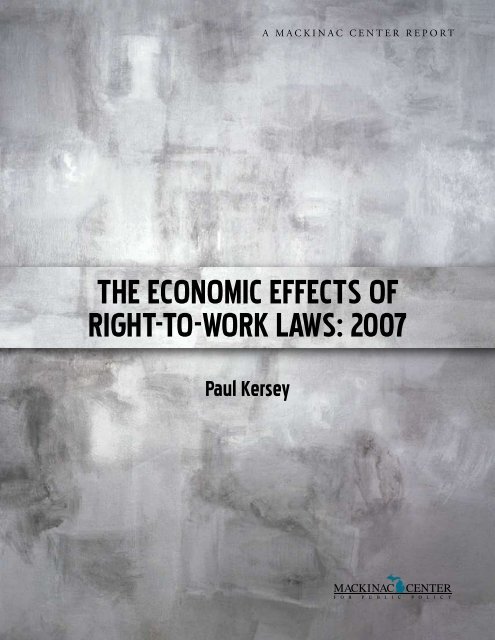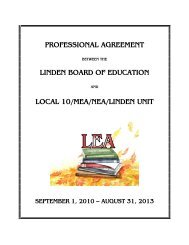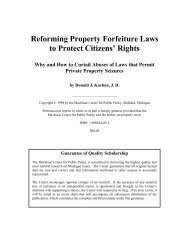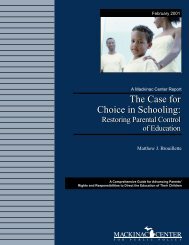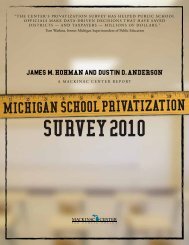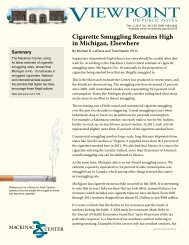The economic effecTs of RighT-To-WoRK LaWs ... - Mackinac Center
The economic effecTs of RighT-To-WoRK LaWs ... - Mackinac Center
The economic effecTs of RighT-To-WoRK LaWs ... - Mackinac Center
- No tags were found...
You also want an ePaper? Increase the reach of your titles
YUMPU automatically turns print PDFs into web optimized ePapers that Google loves.
A M a c k i n a c C e n t e r R e p o r t<strong>The</strong> Economic Effects <strong>of</strong>Right-to-Work Laws: 2007Paul Kersey
<strong>The</strong> <strong>Mackinac</strong> <strong>Center</strong> for Public Policy is a nonpartisan research and educational institute devoted to improvingthe quality <strong>of</strong> life for all Michigan citizens by promoting sound solutions to state and local policy questions. <strong>The</strong><strong>Mackinac</strong> <strong>Center</strong> assists policymakers, scholars, business people, the media and the public by providing objectiveanalysis <strong>of</strong> Michigan issues. <strong>The</strong> goal <strong>of</strong> all <strong>Center</strong> reports, commentaries and educational programs is to equipMichigan citizens and other decision makers to better evaluate policy options. <strong>The</strong> <strong>Mackinac</strong> <strong>Center</strong> for PublicPolicy is broadening the debate on issues that have for many years been dominated by the belief that governmentintervention should be the standard solution. <strong>Center</strong> publications and programs, in contrast, <strong>of</strong>fer an integrated andcomprehensive approach that considers:All Institutions. <strong>The</strong> <strong>Center</strong> examines the important role <strong>of</strong> voluntary associations, communities, businessesand families, as well as government.All People. <strong>Mackinac</strong> <strong>Center</strong> research recognizes the diversity <strong>of</strong> Michigan citizens and treats them as individualswith unique backgrounds, circumstances and goals.All Disciplines. <strong>Center</strong> research incorporates the best understanding <strong>of</strong> <strong>economic</strong>s, science, law, psychology,history and morality, moving beyond mechanical cost‐benefit analysis.All Times. <strong>Center</strong> research evaluates long-term consequences, not simply short-term impact.Committed to its independence, the <strong>Mackinac</strong> <strong>Center</strong> for Public Policy neither seeks nor accepts any governmentfunding. <strong>The</strong> <strong>Center</strong> enjoys the support <strong>of</strong> foundations, individuals and businesses that share a concern for Michigan’sfuture and recognize the important role <strong>of</strong> sound ideas. <strong>The</strong> <strong>Center</strong> is a nonpr<strong>of</strong>it, tax-exempt organization under Section501(c)(3) <strong>of</strong> the Internal Revenue Code. For more information on programs and publications <strong>of</strong> the <strong>Mackinac</strong> <strong>Center</strong>for Public Policy, please contact:<strong>Mackinac</strong> <strong>Center</strong> for Public Policy140 West Main Street • P.O. Box 568 • Midland, Michigan 48640989-631-0900 • Fax 989-631-0964 • www.mackinac.org • mcpp@mackinac.org© 2007 by the <strong>Mackinac</strong> <strong>Center</strong> for Public Policy, Midland, MichiganISBN: 1-890624-67-5 | S2007-11140 West Main Street • P.O. Box 568 • Midland, Michigan 48640989-631-0900 • Fax 989-631-0964 • www.mackinac.org • mcpp@mackinac.org
<strong>The</strong> <strong>Mackinac</strong> <strong>Center</strong> for Public Policy<strong>The</strong> Economic Effects <strong>of</strong>Right-to-Work Laws: 2007Paul Kersey©2007 by the <strong>Mackinac</strong> <strong>Center</strong> for Public PolicyMidland, MichiganGuarantee <strong>of</strong> Quality Scholarship<strong>The</strong> <strong>Mackinac</strong> <strong>Center</strong> for Public Policy is committed to delivering the highest quality and most reliable researchon Michigan issues. <strong>The</strong> <strong>Center</strong> guarantees that all original factual data are true and correct and that informationattributed to other sources is accurately represented.<strong>The</strong> <strong>Center</strong> encourages rigorous critique <strong>of</strong> its research. If the accuracy <strong>of</strong> any material fact or reference to anindependent source is questioned and brought to the <strong>Center</strong>’s attention with supporting evidence, the <strong>Center</strong> willrespond in writing. If an error exists, it will be noted in an errata sheet that will accompany all subsequent distribution<strong>of</strong> the publication, which constitutes the complete and final remedy under this guarantee.
<strong>The</strong> Economic Effects <strong>of</strong> Right-to-Work Laws: 2007iiiContentsExecutive Summary............................................................................................... 1Introduction.......................................................................................................... 1Growth in Gross State Product............................................................................. 5Employment Growth............................................................................................ 6Manufacturing Employment Growth................................................................... 7Construction Employment................................................................................... 8Service Employment............................................................................................. 8Unemployment Rates.......................................................................................... 10Per-Capita Disposable Income........................................................................... 10Poverty Rates....................................................................................................... 12Unit Labor Costs................................................................................................. 13Conclusion.......................................................................................................... 14Acknowledgments............................................................................................... 15About the Author................................................................................................ 15<strong>Mackinac</strong> <strong>Center</strong> for Public Policy
<strong>The</strong> Economic Effects <strong>of</strong> Right-to-Work Laws: 2007Executive SummaryThis paper is an update to Dr. William T. Wilson’s 2002 study, “<strong>The</strong> Effect <strong>of</strong>Right to Work Laws on Economic Development.”In that report, Wilson compared right-to-work and non-right-to-work stateson basic measurements <strong>of</strong> <strong>economic</strong> performance, such as gross state productgrowth, job creation and per-capita disposable income between 1970 and 2000.Wilson found that right-to-work states had significant advantages in <strong>economic</strong>growth and job creation. While incomes were still somewhat lower in right-toworkstates, incomes were also growing faster in those states. Michigan, on nearlyevery <strong>economic</strong> measurement, had lagged behind.This paper picks up where Wilson’s study left <strong>of</strong>f, tracking the same measurementsfrom 2001 to 2006. We find that little has changed — if anything the apparentadvantages <strong>of</strong> right-to-work states have grown larger. <strong>The</strong> economies <strong>of</strong> rightto-workstates grew by an average <strong>of</strong> 3.4 percent compared to 2.6 percent fornon-right-to-work states and 0.7 percent for Michigan. Jobs grew by 1.2 percentannually in right-to-work states, compared to 0.6 percent for non-right-to-workstates, while jobs decreased by an average <strong>of</strong> 0.8 percent in Michigan.Meanwhile, the gap in per-capita disposable income continues to shrink, to thepoint where most right-to-work states are likely to have higher incomes thanMichigan does within just a few years.On several measurements, the trends between 2001 and 2006 were more favorabletowards right-to-work states than they had been in the period covered by Wilson’searlier study. In light <strong>of</strong> Michigan’s current <strong>economic</strong> difficulties, this leads tothe conclusion that the case for making Michigan a right-to-work state has onlybecome stronger.IntroductionIn 2002, the <strong>Mackinac</strong> <strong>Center</strong> for Public Policy published a study written byformer Comerica economist Dr. William T. Wilson titled “<strong>The</strong> Effect <strong>of</strong> Rightto-WorkLaws on Economic Development.” This study compared states that hadenacted right-to-work laws and those that had not using common measurementssuch as gross state product, job creation, per-capita income and poverty rates. Itwas found that states with right-to-work laws had outperformed the other statesin nearly every category, and that Michigan in particular had lagged behind.Five years have passed, and the state has entered a condition <strong>of</strong> steady <strong>economic</strong>stagnation. Michigan-based automobile manufacturers have continued to losemarket share, Michigan’s largest bank has moved its headquarters out <strong>of</strong> state,families have left the state to pursue opportunities elsewhere and political leaderswrestle with the consequences <strong>of</strong> a shrinking economy and declining tax revenues.<strong>Mackinac</strong> <strong>Center</strong> for Public Policy
<strong>The</strong> Economic Effects <strong>of</strong> Right-to-Work Laws: 2007With little grounds for belief that these trends will reverse on their own, Michigan’sresidents are increasingly open to fundamental changes in policy that will makethe state more attractive to entrepreneurs, who are the real creators <strong>of</strong> wealthand jobs. One possible way to attract new investment and business into the statewould be to enact a right-to-work law.This report will pick up where the 2002 study left <strong>of</strong>f, updating fundamentalmeasurements <strong>of</strong> <strong>economic</strong> health and assessing whether the advantages held byright-to-work states in 2002 remain in place in 2007.<strong>The</strong> basic concept <strong>of</strong> a right-to-work law is simple: workers should not be obligatedto join or give support to a union as a condition <strong>of</strong> employment. Under federallaw, workers have both the right to join unions and the right to refrain from unionmembership, and while a union contract will cover all employees within a givenbargaining unit, individual workers are free to join or not join the union at theirdiscretion.But while a strict “union shop” contract, in which all workers covered by acollective bargaining agreement must formally join the union, is prohibited,federal law does allow something similar: the agency shop, in which coveredworkers who opt not to join the union must pay an agency fee, which generally isequal to the regular union dues paid by full union members.<strong>The</strong> agency fee does not render the right to refrain from joining a union into atotal dead letter. A worker who does not join the union is free from legal unionsanctions if he chooses not to take part in a strike, and he can also invoke rightsaffirmed under the Supreme Court’s Beck decision to reduce his agency fee.In theory, his union dues should be limited to a pro rata share <strong>of</strong> the costs <strong>of</strong>collective negotiations and contract administration, including the processing <strong>of</strong>grievances. In practice, Beck rights have proved difficult to enforce — but theremedy is there and <strong>of</strong>fers some relief from supporting union political and socialactivities that workers <strong>of</strong>ten oppose.Many states have given workers complete discretion to decline membership in,and financial support <strong>of</strong>, a union that they individually oppose. Enacting a rightto-worklaw abolishes agency fees and allows workers themselves to decide if aunion deserves their financial support.This policy has much to recommend it from the perspective <strong>of</strong> workersthemselves. While union <strong>of</strong>ficials argue that right-to-work laws allow for “freeriders” to enjoy the benefits <strong>of</strong> union representation without shouldering thecosts, this argument is based on the presumption that all workers gain equallyunder collective bargaining agreements. Unions have the potential to be <strong>of</strong> greatvalue to workers as a representative in contract negotiations, as an advocatein grievances and, if necessary, as a means for united action such as strikes.<strong>Mackinac</strong> <strong>Center</strong> for Public Policy
<strong>The</strong> Economic Effects <strong>of</strong> Right-to-Work Laws: 2007But it is irresponsible for the law to assume that every union contract createsbenefits for every worker it covers: an inept union may agree to terms that arenot advantageous for its members and a corrupted union might sell its membersshort as part <strong>of</strong> a “sweetheart contract.” Union <strong>of</strong>ficials may capriciously decideto favor the interests <strong>of</strong> one group <strong>of</strong> workers over another for entirely personalreasons. Even a capable and conscientious union negotiator may need to choosebetween competing interests among the rank-and-file.Union <strong>of</strong>ficials are not infallible. Given the responsibility that they have asworker representatives, the lines <strong>of</strong> accountability between union and workersshould be as firm as possible. Right-to-work laws strengthen accountability bygiving dissatisfied members the option <strong>of</strong> withdrawing all financial support froma union that they believe is not serving their purposes. In the process, it createsincentives for union <strong>of</strong>ficials to pay attention to the interests <strong>of</strong> all members.This, in turn, reduces the temptation for unions to seek to use their position asworker representatives to influence day-to-day operations in ways that benefitonly a handful <strong>of</strong> members. As a consequence, labor is more productive and moreattractive to employers. In turn, higher labor productivity drives up the demandfor labor in right-to-work states, increasing both wages and the number <strong>of</strong> jobsavailable.In his 2002 study, Wilson found compelling evidence that right-to-work lawsalso improved state <strong>economic</strong> conditions across the board. In particular, between1970 and 2000:• <strong>The</strong> economies <strong>of</strong> right-to-work states grew faster. Between 1977 and 1999the average right-to-work state’s gross state product grew by 3.4 percentannually, compared to 2.9 percent in non-right-to-work states. Michigan’seconomy grew by 1.8 percent during that period.• Between 1970 and 2000 overall employment increased by 2.9 percentannually in right-to-work states versus 2.0 percent for non-right-to-workstates. Job growth in Michigan was barely half that <strong>of</strong> right-to-work statesat 1.5 percent. Manufacturing employment grew by 1.5 percent annually inright-to-work states but declined by 0.2 percent in non-right-to-work statesduring that same period.• <strong>The</strong> unemployment rate between 1978 and 2000 averaged 5.8 percent inright-to-work states versus 6.3 in non-right-to-work states, while Michigan’sunemployment rate averaged 8.1 percent.• Per-capita disposable income was higher in non-right-to-work states thanin right-to-work states, but between 1970 and 2000 per-capita disposableincome was rising faster in states with right-to-work laws, by 0.2 percentannually.<strong>Mackinac</strong> <strong>Center</strong> for Public Policy
<strong>The</strong> Economic Effects <strong>of</strong> Right-to-Work Laws: 2007• From 1969 to 2000 the poverty rate in right–to-work states decreased by6.7 percent, but in non-right-to-work states poverty decreased by only 2.0percent. In Michigan the percentage <strong>of</strong> people living in poverty as defined bythe Census Bureau increased by 0.6 percent during that same period.Wilson also observed that unit labor costs — the cost <strong>of</strong> labor associated with aunit <strong>of</strong> output — were lower in right-to-work states than in non-right-to-workstates, making labor a better overall value in right-to-work states, which, in turn,become more attractive places for businesses to locate. Michigan’s per-unit laborcosts were among the highest in the country, second only to New Jersey’s. 1Wilson’s study found that right-to-work states outperformed non-right-toworkstates in every important <strong>economic</strong> category. Michigan in particular hadperformed poorly, placing in the bottom fifth for most <strong>of</strong> the preceding 30 yearsin <strong>economic</strong> growth, job creation, unit labor costs and change in the poverty rate.While the 1990s were a relative bright spot for Michigan, the growth <strong>of</strong> the state’soverall economy, job creation and income were still little better than average.Wilson expressed particular concern about the state’s high labor costs and theirimplications for the state’s future: “As the forces <strong>of</strong> globalization and competitionintensify, Michigan’s high unit labor costs will increasingly discourage freshcapital from planting new seeds.” 21 Wilson, William, <strong>The</strong> Effect <strong>of</strong>Right-to-Work Laws on EconomicDevelopment, <strong>Mackinac</strong> <strong>Center</strong>for Public Policy, June 2002(hereinafter “Wilson study”).2 Wilson study, 25.<strong>The</strong>se words appear to have been prophetic, as Michigan has encountered astring <strong>of</strong> <strong>economic</strong> setbacks at a time when the rest <strong>of</strong> the United States isexperiencing steady <strong>economic</strong> growth. <strong>The</strong> accelerated decline <strong>of</strong> Detroit’sautomobile industry, evidenced by mass lay<strong>of</strong>fs and buyout <strong>of</strong> employees at themain domestic auto manufacturers and the nettlesome Delphi bankruptcy, hasgenerated constant headlines. At the same time, the state has largely failed toattract employers seeking to expand out <strong>of</strong> other states or to develop successful,growing firms from within.<strong>The</strong> quickening erosion <strong>of</strong> jobs from the automotive industry, combined withthe failure to attract new investment or develop new companies, has left thestate with a declining tax base. In combination with structural flaws that makegovernment services more expensive — binding arbitration <strong>of</strong> labor disputesinvolving public safety <strong>of</strong>ficers, an expensive public employee pension systemand a severe prevailing wage law pegged strictly to union construction wages— this has led to a more or less constant budget crunch in Lansing and in manycounty and municipal governments.This report will update Wilson’s work, focusing on the <strong>economic</strong> performance <strong>of</strong>right-to-work and non-right-to-work states over the five year period from 2001to 2006. For the purposes <strong>of</strong> this report, Oklahoma, which passed a right-toworklaw by referendum in 2001, will be treated as a right-to-work state unlessotherwise noted.<strong>Mackinac</strong> <strong>Center</strong> for Public Policy
<strong>The</strong> Economic Effects <strong>of</strong> Right-to-Work Laws: 2007For the most part, this paper will examine the same fundamental <strong>economic</strong>measurements <strong>of</strong> <strong>economic</strong> growth, employment, income and productivity asthe Wilson study. It should be noted that this period opens at the beginning<strong>of</strong> a brief national recession occasioned by the terrorist attacks <strong>of</strong> September2001 and also includes the aftermath <strong>of</strong> Hurricane Katrina in August 2005. Asa consequence, growth rates in employment and wages are somewhat lower forall states than for the period measured by Wilson, which generally covers theperiod from 1970 to 2000. Because Katrina mainly affected the right-to-workstates <strong>of</strong> Louisiana, Mississippi and Alabama, the data may actually understatethe value <strong>of</strong> right-to-work laws. Nonetheless, these measurements will showthat the case for a Michigan right-to-work law remains strong and, if anything,has become stronger.By themselves these statistical measurements do not prove that right-to-worklaws alone are responsible for dramatic <strong>economic</strong> improvement; correlationsuggests causation, but the two are not the same. But at a minimum, it seemsfair to conclude that right-to-work laws are not incompatible with a strong stateeconomy, high growth in jobs, low unemployment and steady wage gains. And itis certainly logical to ask right-to-work critics what exactly does cause right-toworkstates to outperform non-right-to-work states in so many measurements <strong>of</strong><strong>economic</strong> health.It is not our intention to make the right-to-work concept into a panacea, nordo we claim that right-to-work laws are an absolute necessity before Michigan’seconomy can recover. <strong>The</strong>re are a large number <strong>of</strong> public policies that can affect astate’s economy: high taxation levels, counterproductive government programs,state laws (such as the prevailing wage) that make necessary state activitiesneedlessly expensive, and regulatory burdens that impede <strong>economic</strong> growth andlimit employment. Michigan could probably become a leading state by reducingtaxes and streamlining environmental rules, but in the absence <strong>of</strong> a right-to-worklaw, the fiscal and regulatory remedies would need to be more stringent. Passingright-to-work legislation is a step Michigan can take to make the state moreattractive to employers and create jobs without complicating already difficultbudget decisions or taking any environmental risks.Growth in Gross State ProductReal gross state product is the market value <strong>of</strong> all goods and services produced ina state over the course <strong>of</strong> a year, corrected to account for inflation. Real GSP is themost basic measurement <strong>of</strong> <strong>economic</strong> growth. Over the five-year period between2001 and 2006, the average right-to-work state saw its gross state product growby 18.1 percent, versus 13.6 percent for non-right-to-work states. 3 During thatsame period Michigan’s gross state product grew by only 3.4 percent, easily theslowest growth <strong>of</strong> any state in the union. Next-to-last West Virginia, another nonright-to-workstate, managed GSP growth <strong>of</strong> 7.3 percent. <strong>The</strong> lowest performing3 <strong>Mackinac</strong> <strong>Center</strong> calculationsbased on Bureau <strong>of</strong> EconomicAffairs data.<strong>Mackinac</strong> <strong>Center</strong> for Public Policy
<strong>The</strong> Economic Effects <strong>of</strong> Right-to-Work Laws: 2007Graphic 1: <strong>To</strong>tal percentage growth ingross state product, 2001-200620151018.113.6Percent53.4Right-to-work Non-right-to-work Michiganaverage averageSource: <strong>Mackinac</strong> <strong>Center</strong> calculations based onU.S. Bureau <strong>of</strong> Economics Analysis dataright-to-work states were Louisiana and Mississippi, both <strong>of</strong> which were struckby Hurricane Katrina in August 2005, yet both outperformed Michigan, with realGSP growth <strong>of</strong> 9.2 and 9.5 percent respectively. 44 Ibid.In the 2002 report, Wilson found that between 1977 and 1999 right-to-workstates had an average annual (year-to-year, as opposed to cumulative) GSP growthrate <strong>of</strong> 3.4 percent, versus 2.9 percent for non-right-to-work and 1.8 percentfor Michigan. This GSP growth gap <strong>of</strong> half a percent per year, while modest inappearance, had a significant impact when repeated over 30 years. That growthgap has gotten larger: between 2001 and 2006 annual GSP growth averaged 3.4percent in right-to-work states, compared with 2.6 percent in non-right-to-workstates, a difference <strong>of</strong> 0.8 percent. Michigan’s annual GSP growth during thatsame period was only 0.7 percent.Employment GrowthA growing state economy reflects the success <strong>of</strong> entrepreneurs in developing newbusinesses or expanding existing ones, creating opportunities for workers in theprocess. It should not come as a surprise, then, that right-to-work states, withtheir higher rates <strong>of</strong> overall growth, show a significant edge in creating jobs.Between 1970 and 2000 employment grew by an average <strong>of</strong> 2.9 percent annuallyin right-to-work states, versus 2.0 percent in non-right-to-work states and 1.5percent in Michigan. From 2001 to 2006 the rate <strong>of</strong> employment growth appearedto slow somewhat across the country, but right-to-work states still had a decidedadvantage, with average annual job growth <strong>of</strong> 1.2 percent compared to 0.6 percentfor non-right-to-work states. 5Over the full five-year period from 2001 to 2006, the average right-to-workstate increased employment by 6.4 percent, while non-right-to-work statesaveraged 2.9 percent in job growth. Michigan saw employment decline by4.8 percent — again, the worst performance in the nation — representing theloss <strong>of</strong> more than 220,000 jobs. 6 Only three other states lost jobs during thisperiod, non-right-to-work Illinois and Ohio, and right-to-work Louisiana.Aside from Katrina-ravaged Louisiana, the right-to-work state with the worstjob-creation record from 2001 to 2006 was Kansas, which managed to increase5 <strong>Mackinac</strong> <strong>Center</strong> calculationsbased on data from the Bureau<strong>of</strong> Labor Statistics, CurrentEmployment Statistics.6 Ibid.<strong>Mackinac</strong> <strong>Center</strong> for Public Policy
<strong>The</strong> Economic Effects <strong>of</strong> Right-to-Work Laws: 2007Graphic 2: <strong>To</strong>tal percentage change innon-farm employment, 2001-20068406.42.9Percent-4-8-4.8Right-to-work Non-right-to-work Michiganaverage averageSource: <strong>Mackinac</strong> <strong>Center</strong> calculations based on U.S. Bureau<strong>of</strong> Labor Statistics, Current Employment Statisticsnonfarm employment by 0.4 percent. If Michigan had merely kept pace withKansas during that period, the state would have had 238,000 more jobs than itdid. 77 Ibid.Manufacturing Employment GrowthManufacturing has long been a mainstay <strong>of</strong> the Michigan economy and animportant source <strong>of</strong> employment across the country. Over the last five yearsMichigan has lost a large number <strong>of</strong> manufacturing jobs, especially in theautomobile sector. Michigan is far from alone in this; most states saw declinesin manufacturing employment between 2001 and 2006. But right-to-work statessaw much less severe losses in this area.<strong>The</strong> trend away from manufacturing employment was already well underwayfive years ago; nationally, manufacturing employment reached its peak in 1979.Between 1990 and 2000 right-to-work states experienced an average increase <strong>of</strong>1.0 percent annually in manufacturing employment, but non-right-to-work statessaw annual declines in manufacturing payroll averaging 0.6 percent. Michigan,in the midst <strong>of</strong> a stretch <strong>of</strong> relative prosperity, gained manufacturing jobs by anaverage <strong>of</strong> 0.4 percent per year during that time, but had experienced losses in the1980s. 8<strong>The</strong> tendency for non-right-to-work states to lose manufacturing jobs hasbecome more pronounced over the last several years. Between 2001 and 2006 thetypical right-to-work state saw manufacturing employment decline 1.5 percentannually, 7.1 percent overall. Non-right-to-work states, however, faced evensharper declines: averaging 3.0 percent annually and 13.7 percent over the fiveyearperiod. Every non-right-to-work state but one, Alaska, lost manufacturingjobs during that period, while five right-to-work states registered at least modestgains in this area. 9It will come as no surprise to most readers that Michigan’s record for manufacturingemployment over the last five years is particularly disturbing: between 2001and 2006 Michigan manufacturing employment declined an average <strong>of</strong> 4.6 percentper-year, or by a total <strong>of</strong> 20.9 percent over the whole five-year period. 108 Wilson study, 27.9 <strong>Mackinac</strong> <strong>Center</strong> calculationsbased on data from the Bureau<strong>of</strong> Labor Statistics, CurrentEmployment Statistics.10 Ibid.<strong>Mackinac</strong> <strong>Center</strong> for Public Policy
<strong>The</strong> Economic Effects <strong>of</strong> Right-to-Work Laws: 2007Graphic 3: <strong>To</strong>tal percentage losses inmanufacturing employment, 2001-20060Percent-5-10-15-20-7.1-13.7-20.9Right-to-work Non-right-to-work Michiganaverage averageSource: <strong>Mackinac</strong> <strong>Center</strong> calculations based on U.S. Bureau<strong>of</strong> Labor Statistics, Current Employment Statistics<strong>The</strong> decline in manufacturing employment is occurring nationwide and has beenunderway for nearly 30 years; large statewide gains in manufacturing employmentare unlikely even with the best <strong>economic</strong> policies. But given Michigan’s status asone <strong>of</strong> the most heavily industrialized states in the union, with 14.9 <strong>of</strong> Michigan’sworkforce in manufacturing compared to the national average <strong>of</strong> 10.2 percent,Michigan has a particular interest in preserving manufacturing employment asmuch as possible, an area where states with right-to-work laws appear to have adistinct advantage. 1111 Ibid.Construction EmploymentBetween 1970 and 2000 employment in construction grew nearly half again asfast in right-to-work states. This trend was particularly sharp in the 1990s as theaverage annual growth in construction jobs reached 4.4 percent in right-to-workstates versus 2.5 percent in non-right-to-work states. 12Since then, construction employment has slowed down somewhat, but rightto-workstates continue to have a definite edge. Between 2001 and 2006 nonright-to-workstates increased construction payrolls by an average <strong>of</strong> 1.7 percentper year or 9.5 percent for the five-year period. Right-to-work states increasedtheir construction payrolls by 3.3 percent per year, which translates into18.3 percent for the entire period, nearly double the growth rate <strong>of</strong> non-right-toworkstates. 13Four states, all non-right-to-work, experienced declines. Michigan saw thesharpest decline, losing 12.6 percent <strong>of</strong> its construction payroll over the five-yearperiod, an average <strong>of</strong> 2.7 percent decline per year. 1412 Wilson study, 16-17.13 <strong>Mackinac</strong> <strong>Center</strong> calculationsbased on data from the Bureau<strong>of</strong> Labor Statistics, CurrentEmployment Statistics. Statisticsnot available for Delaware,Hawaii, Maryland and Nebraska.14 Ibid.Service EmploymentWhile Wilson’s 2002 study did not address employment in the services sector,this is a growing area <strong>of</strong> the economy that is expected to provide the vast majority<strong>of</strong> new jobs for the foreseeable future. According to Bureau <strong>of</strong> Labor Statisticsprojections, 18.7 million out <strong>of</strong> 18.9 million new jobs created between 2004and 2014 will be in the service sector. 15 If Michigan is to replace jobs lost from15 Bureau <strong>of</strong> LaborStatistics, <strong>To</strong>morrow’s Jobs,<strong>The</strong> Occupational OutlookHandbook 2006-07 Edition, p. 2,available online at http://www.bls.gov/oco/pdf/oco2003.pdf.<strong>Mackinac</strong> <strong>Center</strong> for Public Policy
<strong>The</strong> Economic Effects <strong>of</strong> Right-to-Work Laws: 2007Graphic 4: <strong>To</strong>tal percentage change inconstruction employment, 2001-20062010018.39.5Percent-10-20-12.6Right-to-work Non-right-to-work Michiganaverage averageSource: <strong>Mackinac</strong> <strong>Center</strong> calculations based on U.S. Bureau<strong>of</strong> Labor Statistics, Current Employment Statisticsthe retrenchment <strong>of</strong> automakers, the new jobs are far more likely to be foundin services than in manufacturing. Sometimes derided as “burger-flipping,” theservices sector also includes well-compensated careers in health care, education,law, consulting, architecture and technology. 16Job creation in the service sector has also favored right-to-work states for sometime. Between 1990 and 2000, right-to work states added service-sector jobs atan average rate <strong>of</strong> 5.8 percent per year, while non-right-to-work states did so at arespectable — but not quite as rapid — rate <strong>of</strong> 4.1 percent per year. 17While job creation has slowed somewhat since then, right-to-work states haveretained their advantage. Between 2001 and 2006, right-to work states increasedservice-sector payrolls by 7.5 percent, or a little more than 1.4 percent per year.That was more than half again the rate <strong>of</strong> non-right-to-work states, which onaverage increased service-sector employment by 4.7 percent over the five-yearperiod, or 0.9 percent per year. 18Michigan’s performance, again, was among the worst in the nation; from 2001to 2006 Michigan lost 0.6 percent <strong>of</strong> its service-sector payroll, an averageannual decline <strong>of</strong> 0.1 percent. 19 Only Louisiana, struck by Hurricane Katrinain 2005, fared worse. Because service-sector jobs in particular tend to focuson interactions with customers, the effects <strong>of</strong> Hurricane Katrina and thesubsequent evacuation <strong>of</strong> New Orleans are likely to be particularly acute and,consequently, Louisiana’s poor performance in creating service-sector jobsshould be considered an anomaly.16 Ibid., 2-3.17 <strong>Mackinac</strong> <strong>Center</strong>calculations based on data fromthe Bureau <strong>of</strong> Labor Statistics,Current Employment Statistics.18 Ibid.19 Ibid.Graphic 5: <strong>To</strong>tal percentage change inservice-sector employment, 2001-20067.552.57.54.7Percent0-2.5-0.6Right-to-work Non-right-to-work Michiganaverage averageSource: <strong>Mackinac</strong> <strong>Center</strong> calculations based on U.S. Bureau<strong>of</strong> Labor Statistics, Current Employment Statistics<strong>Mackinac</strong> <strong>Center</strong> for Public Policy
<strong>The</strong> Economic Effects <strong>of</strong> Right-to-Work Laws: 2007 10Unemployment RatesWith slower job growth — and sharp job losses in manufacturing — one naturallywould expect to see higher unemployment rates in non-right-to-work states. Thisheld true between 1978 and 2000: right-to-work states had an average unemploymentrate <strong>of</strong> 5.8 percent versus 6.3 for non-right-to-work states. Michigan, inspite <strong>of</strong> its relative prosperity during the 1990s, had a poor record for unemploymentfor the period, with an average unemployment rate <strong>of</strong> 8.1 percent. 20Unemployment rates were lower overall from 2001 to 2006, and the gapsbetween right-to-work and non-right-to-work states (including Michigan)tightened somewhat, but right-to-work states still tended to have lower rates <strong>of</strong>unemployment: 4.8 percent for right-to-work states, 5.1 percent for non-rightto-workstates and 6.5 percent for Michigan. 21<strong>The</strong> unemployment rate for Michigan may understate the difficulty that Michiganworkers have in finding jobs. From 2000 to 2006 the Census estimates thatMichigan’s population grew by only 1.6 percent, while the national populationgrew by 6.4 percent. 22 Data compiled by United Van Lines, one <strong>of</strong> the nation’slargest movers, indicates that in 2006 Michigan was tied with North Dakota forthe highest rate <strong>of</strong> outbound migration in the country, with nearly two familiesleaving the state for every family moving in. <strong>The</strong> families that move out will notshow up in the state’s unemployment figures, but it is very likely that many <strong>of</strong> themare the families <strong>of</strong> Michigan workers who could not find jobs close to home.Per-Capita Disposable IncomeA common argument against right-to-work is that by weakening unions, rightto-worklaws drive down compensation. In 2002, Wilson observed that rightto-workopponents “have <strong>of</strong>ten acknowledged the faster employment growthin right-to-work states, but counter that it comes at the expense <strong>of</strong> much lowerwages and incomes. Organized labor’s mantra, the ‘right-to-work for less’ or the‘right-to-starve’ has resonated strongly both inside and outside union circles.” 23This rhetorical flourish had some basis in fact: Wilson found that per-capitadisposable income, essentially income after taxes, was approximately $2,850lower in states without right-to-work laws. 2420 Wilson study, 17.21 <strong>Mackinac</strong> <strong>Center</strong>calculations based on data fromthe Bureau <strong>of</strong> Labor Statistics,Current Employment Statistics.22 U.S. Census Bureau.23 Wilson study, 18 (emphasisin original).24 Ibid.Wilson argued that other factors related to compensation swung the advantageback to right-to-work supporters on the question <strong>of</strong> compensation. Several studieshad found that non-right-to-work states tended to have higher costs <strong>of</strong> living, andthat after accounting for this, compensation was actually higher in right-to-workstates. Wilson also found that per-capita disposable income was growing a bitmore quickly in right-to-work states; between 1970 and 2001 the average annualper-capita income growth in right-to-work states was 6.8 percent, compared with6.6 percent in non-right-to-work states. (Michigan also averaged 6.6 percent.)<strong>Mackinac</strong> <strong>Center</strong> for Public Policy
<strong>The</strong> Economic Effects <strong>of</strong> Right-to-Work Laws: 2007 11Graphic 6: Projected per-capitadisposable income for Michigan andright-to-work states, 2010Salary in thousands $20 $30 $40 $50WyomingVirginiaSouth DakotaNevadaFloridaKansasTexasNebraskaNorth DakotaIowaLouisianaOklahomaFurther research by University <strong>of</strong>Oklahoma economist W. Robert Reed hassuggested that much <strong>of</strong> the gap in incomefavoring non-right-to-work states wasdue to the fact that many right-to-work17.9states had been relatively poor prior toenacting right-to-work legislation. Afteraccounting for <strong>economic</strong> conditions priorto enactment, Reed found that a significant,positive impact was associated with rightto-work.25TennesseeAlabamaSince Wilson’s paper was released, the differencein wage growth appears to have wid-MichiganNorth Carolinaened slightly: Per-capita disposable incomeArizonaIdahoincreased by an average <strong>of</strong> 4.3 percent perGeorgiayear in right-to-work states, compared toSouth CarolinaUtah3.9 percent per year in non-right-to-workArkansasstates between 2001 and 2006, a difference <strong>of</strong>Mississippi0.4 percentage points. Per-capital disposableincome grew more slowly in Michigan,Source: <strong>Mackinac</strong> <strong>Center</strong> calculations based on U.S. Bureau <strong>of</strong> Labor Statisticsaveraging 3.0 percent per year. Only one right-to-work state, Georgia, had slowerper-capita disposable income growth than Michigan during this period.25 Reed, Robert, How Right-to-Work Laws Affect Wages, Journal <strong>of</strong>Labor Research, Vol. 24, No. 4(2003): 713-730.<strong>The</strong>se seemingly small changes have potentially dramatic ramifications: if thetrend <strong>of</strong> the last five years continues, it is simply a matter <strong>of</strong> time before rightto-workstates <strong>of</strong>fer not only more jobs, but better paying jobs, than Michigan.<strong>The</strong> per-capita disposable income gap between Michigan and the average rightto-workstate has already declined considerably, from $2,300 in 2001 to less than$1,000 in 2006.As far back as 2001, three right-to work states, Nevada, Virginia and Wyoming,already had higher per-capita disposable income than Michigan. 26 Between 2001and 2006, five more right-to-work states (Florida, Kansas, Nebraska, SouthDakota and Texas) overtook Michigan. Assuming current trends hold, six moreright-to-work states are poised to feature higher disposable income by 2010:Alabama, Iowa, Louisiana, North Dakota, Oklahoma and Tennessee. At thispoint, a majority <strong>of</strong> “right-to-work for less” states will exceed Michigan in percapitadisposable income. 27Looking further into the future, every right-to-work state except Georgia willovertake Michigan by 2036 if the trend <strong>of</strong> the last five years holds. This projectionshould be taken with a grain <strong>of</strong> salt; much can and will change between nowand 2036. But the exercise does illustrate one final, important point about thegap in wages between right-to-work and non-right-to-work states: the gap is real26 Bureau <strong>of</strong> EconomicAnalysis.27 <strong>Mackinac</strong> <strong>Center</strong>calculations based on datafrom the Bureau <strong>of</strong> EconomicAnalysis.<strong>Mackinac</strong> <strong>Center</strong> for Public Policy
<strong>The</strong> Economic Effects <strong>of</strong> Right-to-Work Laws: 2007 12but it is not so large that it cannot be overcome, in the lifetime <strong>of</strong> many workingMichiganians, by states with the sort <strong>of</strong> advantage in <strong>economic</strong> development thatright-to-work appears to <strong>of</strong>fer.Poverty RatesPoverty rates are measured by determining the number <strong>of</strong> people living inhouseholds with an income below a defined amount, called the poverty line,which is adjusted for family size. In his earlier study, Bill Wilson found thatright-to-work states had historically been burdened by high poverty rates, butalso found that they had great success in diminishing poverty. Between 1969 and2000 poverty rates had dropped by 6.7 percent on average in right-to-work states,compared with a reduction <strong>of</strong> 2.0 percent in non-right-to-work states. 28During the 2001-2005 period, rates <strong>of</strong> poverty increased somewhat on account <strong>of</strong>a recession that affected both right-to-work and non-right-to-work states. Rightto-workstates still had higher poverty rates on average than non-right-to-workstates, although the gap between the two did close slightly. For right-to-workstates, poverty rates increased from an average <strong>of</strong> 12.9 in 2000 to 14.0 percentin 2006, an increase <strong>of</strong> 1.1 percentage points. In non-right-to-work states, theaverage poverty rate moved from 10.9 percent to 12.1 percent, an increase <strong>of</strong>1.2 percentage points. While right-to-work states tend to have higher rates <strong>of</strong>poverty, the gap has been narrowing for 30 years and that narrowing continuedover the past five years. Michigan, meanwhile, saw its rate <strong>of</strong> poverty increase sharply, with the number <strong>of</strong>Michiganians living in poverty jumping from 10.1 percent in 2000 to 13.2 percentin 2005. According to the latest figures, Michigan has a higher poverty rate thannine right-to-work states.<strong>The</strong> method for determining poverty has been heavily criticized for beingsimplistic and arbitrary. Generally there is no adjustment made for local costs <strong>of</strong>living, which as we showed is generally lower in right-to-work states, a tendencythat could inflate poverty rates. 29 Also, the tendency to focus on a single year’sincome can result in families with substantial savings from previous years beingtreated as poor. Even the process <strong>of</strong> determining an appropriate “poverty line”itself is somewhat subjective. 30 While the relative poverty rates <strong>of</strong> right-to-workand non-right-to-work states is worth considering, the arbitrariness <strong>of</strong> thismeasurement should lead citizens and policymakers to give this one particularstatistic less weight than the measurements <strong>of</strong> <strong>economic</strong> growth, job creation,unemployment and income.28 Wilson study, 21.* 2005 is the last year for whichpoverty rates are available at thetime this is written. Because <strong>of</strong>the years covered, Oklahoma,which enacted right-to-work in2001, will be disregarded.† <strong>Mackinac</strong> <strong>Center</strong> calculationsbased on data from theU.S. Census Bureau, AmericanCommunity Survey (2006figures not available at time <strong>of</strong>publication).29 U.S. Census Bureau,How the Census Bureau MeasuresPoverty, available online athttp://www.census.gov/hhes/www/poverty/povdef.html.30 Rector, Robert,<strong>The</strong> Myth <strong>of</strong> Widespread AmericanPoverty, Heritage FoundationBackgrounder #1221,September 18, 1998.<strong>Mackinac</strong> <strong>Center</strong> for Public Policy
<strong>The</strong> Economic Effects <strong>of</strong> Right-to-Work Laws: 2007 13Unit Labor Costs<strong>The</strong> last measurement <strong>of</strong> <strong>economic</strong> performance that this report will consider isarguably the most important for the long-term health <strong>of</strong> the state: the productivity<strong>of</strong> labor. For these purposes we use a measurement that reflects the cost <strong>of</strong> laborto employers, the unit labor cost index calculated by Moody’s Economy.com.This index reflects labor compensation relative to productivity for each state. 3131 Wilson study, 20.This is not merely a measure <strong>of</strong> compensation per hour; consequently, lower costsdo not necessarily translate into lower wages or less generous pension and healthcarebenefits. A high-wage state can be competitive in this measurement as longas labor produces enough output to justify the compensation.In 2000, Michigan’s unit labor costs were among the highest in the nation, at 109.2.Only New Jersey had higher labor costs than Michigan. Overall the average labor costindex for right-to-work states was 4.9 points lower than for non-right-to-work states,meaning that labor was roughly 5 percent more productive in right-to-work states. 32By 2005, Michigan’s per-unit labor costs had improved somewhat, dropping to105. But several other high-labor-cost states have also seen improvements inproductivity; consequently the only two states with higher per-unit labor coststhan Michigan are Massachusetts and Maryland. And the advantage held by rightto-workstates has grown to an average <strong>of</strong> 6.4 points. 33While Michigan’s labor cost has been reduced somewhat, the state remains at asignificant disadvantage in this area. Unit labor costs are arguably the single largestcomponent in determining competitiveness. In calculating its state business costindex, Moody’s Economy.com will use labor costs as 75 percent <strong>of</strong> the overallindex, more than all other factors combined. 34Michigan’s high labor costs have a severe effect on the state’s ability to attractand retain employers. A <strong>Mackinac</strong> <strong>Center</strong> review <strong>of</strong> applications for business taxrelief that were submitted to the Michigan Economic Development Commissionfound that 66 percent <strong>of</strong> applicants listed the costs <strong>of</strong> employment in Michiganas a reason they were likely to locate or expand elsewhere. By comparison, only40 percent mentioned taxes, 34 percent listed building costs and 31 percentdescribed <strong>economic</strong> incentives given by other states. 35As communications and transportation become more advanced, the opportunitiesfor businesses to reach new markets have expanded greatly, but at the same timeso has the level <strong>of</strong> competition. In such an environment, it is essential that laborcosts be in line with labor productivity. Michigan’s high per-unit labor costs arelikely to remain a serious burden on the state’s economy, dragging down bothjob creation and wages. Addressing this problem does not mean reducing wagesand benefits, but if high wages are to be preserved they must be matched by highoutput, high quality and workplace flexibility.32 Ibid.33 <strong>Mackinac</strong> <strong>Center</strong>calculations based on datafound in the North AmericanBusiness Cost Review, 2006 Edition,available through Moody’sEconomy.com.34 North American BusinessCost Review, 2006 Edition, p. 4,available through Moody’sEconomy.com.35 <strong>Mackinac</strong> <strong>Center</strong> analysis<strong>of</strong> applications submitted to theMichigan Economic GrowthAgency. <strong>To</strong>tals add up to morethan 100 percent becauseapplicants frequently gave morethan one reason for locatingoutside <strong>of</strong> Michigan.<strong>Mackinac</strong> <strong>Center</strong> for Public Policy
<strong>The</strong> Economic Effects <strong>of</strong> Right-to-Work Laws: 2007 14ConclusionRight-to-work laws change the incentive structure for unions. Because a unionin a right-to-work state must persuade individual workers to pay union dues,unions are more likely to focus on bread-and-butter issues <strong>of</strong> pay, benefits andworking conditions that provide immediate benefits to workers, and less likelyto negotiate complex agreements that enhance their control over the workplace— and unionized workers — at the cost <strong>of</strong> impeding productivity. 36As a consequence, unions in right-to-work states are less <strong>of</strong> a drain on productivity,but not at the expense <strong>of</strong> workers. <strong>The</strong> benefits for employers are obvious; ina right-to-work state employers receive more productivity for each employeecompensation dollar.36 Reid, Joseph, and Faith,Roger, Right-to-Work andUnion Compensation Structure,Journal <strong>of</strong> Labor Research,Vol. 8, No. 2 (Spring 1987).For employees, the benefit <strong>of</strong> a right-to-work law may be less obvious, but flowsinevitably from fundamental <strong>economic</strong>s: higher labor productivity in right-toworkstates results in more demand for labor, and as demand increases, more jobsare <strong>of</strong>fered and the wages attached to those jobs go up. <strong>The</strong> basic <strong>economic</strong> recordbears this out: both jobs and wages are increasing faster in right-to-work states, awin-win proposition for workers.If anything the advantage <strong>of</strong> right-to-work status is growing: comparing the 30-year period from 1970 to 2000 that Wilson covered with the 2001-2006 periodcovered by this report, we find larger gaps in GSP growth and job creation, bothin favor <strong>of</strong> right-to-work states. Disposable income remains lower in right-toworkstates, but right to-work states had been “catching up” in this category priorto 2000. <strong>The</strong> process accelerated between 2001 and 2006 to the point where thetypical right-to-work state will surpass Michigan in a few years.For Michigan, a state undergoing a difficult <strong>economic</strong> transition, the enactment <strong>of</strong>right-to-work legislation would make the state’s workers more attractive to new employers,giving a boost to employment and wages at a time when both are sagging.Michigan has a right to be proud <strong>of</strong> its past as a leader in providing workerswith plentiful jobs at excellent wages, but its residents and political leaders mustrecognize that policies that were effective in the past are not viable now. <strong>The</strong>state’s acceptance <strong>of</strong> compulsory union membership, and the burdens it placedon employers, could be borne easily when the state was the center <strong>of</strong> a lucrativeindustry that faced little competition.But all industries confront new competition, and the auto industry in particularfaces new competitors that do not bear that burden <strong>of</strong> compulsory unionism,either because they have avoided union representation or because they havelocated in right-to-work states. Michigan should not let pride in its past blindit to changes that are taking place today. <strong>The</strong> right-to-work states are poised toovertake Michigan in both job creation and wages. It is doubtful that Michigancan beat them. <strong>The</strong> state would be better <strong>of</strong>f joining them.<strong>Mackinac</strong> <strong>Center</strong> for Public Policy
<strong>The</strong> Economic Effects <strong>of</strong> Right-to-Work Laws: 2007 15Acknowledgments<strong>The</strong> author would like to express his gratitude to Fiscal Policy Research AssistantJames Hohman and Research Intern Aaron Mead, both <strong>of</strong> whom providedinvaluable assistance in assembling the data for this report.About the AuthorPaul Kersey is senior labor policy analyst at the <strong>Mackinac</strong> <strong>Center</strong> for PublicPolicy, where he researches and analyzes labor and employment issues for the<strong>Center</strong>’s Labor Policy Initiative.After practicing law in Livonia, Mich., for several years, Kersey served on thestaff <strong>of</strong> the U.S. House <strong>of</strong> Representatives Government Reform and OversightCommittee. He then spent three years at the National Right to Work Committeeas director <strong>of</strong> state legislation. In that role, he analyzed and responded to laborlegislation in all 50 states. Kersey also spent one year as Bradley Visiting Fellowat the Heritage Foundation, a think tank based in Washington, D.C.Kersey holds a Bachelor <strong>of</strong> Arts degree in <strong>economic</strong>s from the University <strong>of</strong>Michigan-Dearborn. In 1993, he received his juris doctor from the University <strong>of</strong>Illinois.<strong>Mackinac</strong> <strong>Center</strong> for Public Policy
Board<strong>of</strong> DirectorsD. Joseph Olson, ChairmanSenior Vice President and General Counsel,Amerisure CompaniesLawrence W. Reed, President<strong>Mackinac</strong> <strong>Center</strong> for Public PolicyJoseph J. FitzsimmonsRetired President,University Micr<strong>of</strong>ilmsHon. Paul V. GadolaU.S. District Court JudgeRichard G. HaworthChairman <strong>of</strong> the Board,Haworth, Inc.Phil F. JenkinsCEO, Sweepster Inc.Edward C. Levy Jr.President, Edw. C. Levy Co.Rodney M. Lockwood Jr.President,Lockwood Construction Company, Inc.Joseph P. MaguirePresident,Wolverine Development CorporationRichard D. McLellanAttorney, Dykema GossettJohn E. Riecker<strong>of</strong> Counsel to Braun, Kendrick,Finkbeiner, PLCJames M. RodneyChairman <strong>of</strong> the Board,Detroit Forming Inc.Linda K. RodneyAttorney at Law, Law Offices<strong>of</strong> Linda K. Rodney, P.C.Board <strong>of</strong> ScholarsDr. Donald AlexanderWestern Michigan UniversityDr. William AllenMichigan State UniversityDr. Thomas BertonneauWriter and Independent ScholarDr. Brad BirzerHillsdale CollegeDr. Peter BoettkeGeorge Mason UniversityDr. <strong>The</strong>odore BolemaLaw Offices <strong>of</strong> <strong>The</strong>odore BolemaDr. Stephen ColarelliCentral Michigan UniversityAndrew CoulsonCato InstituteRobert CrownerEastern Michigan University (ret.)Dr. Richard CutlerUniversity <strong>of</strong> Michigan (ret.)Dr. Richard EbelingFoundation <strong>of</strong> Economic EducationDr. Jefferson EdgensMorehead State UniversityDr. David FelbeckUniversity <strong>of</strong> Michigan (ret.)Dr. Burton FolsomHillsdale CollegeDr. Wayland GardnerWestern Michigan University (ret.)John GretherNorthwood UniversityDr. Michael HeberlingBaker CollegeDr. Ormand HookMecosta-Osceola Intermediate School DistrictRobert Hunter<strong>Mackinac</strong> <strong>Center</strong> for Public PolicyPr<strong>of</strong>. Harry HutchisonWayne State UniversityDr. David JandaInstitute for Preventative Sports MedicineAnnette KirkRussell Kirk <strong>Center</strong> for Cultural RenewalDavid Littmann<strong>Mackinac</strong> <strong>Center</strong> for Public PolicyDr. Dale MatcheckNorthwood UniversityDr. Paul McCrackenUniversity <strong>of</strong> Michigan (ret.)Charles MeiserLake SuperiorState University (ret.)Glenn MootsNorthwood UniversityDr. George Nastas IIIMarketing ConsultantsDr. John PaffordNorthwood UniversityDr. Mark PerryUniversity <strong>of</strong> Michigan - FlintDr. Leonard PlachtaCentral Michigan University (ret.)Gregory RehmkeEconomic Thinking/E Pluribus Unum FilmsDr. Steve SafranekAve Maria School <strong>of</strong> LawDr. Howard SchwartzOakland UniversityJames SheehanDeutsche Bank SecuritiesRev. Robert SiricoActon Institute for theStudy <strong>of</strong> Religion and LibertyDr. Bradley SmithCapital University Law SchoolDr. John TaylorGrand Valley State UniversityDr. Richard K. VedderOhio UniversityPr<strong>of</strong>. Harry Veryser Jr.Walsh CollegeJohn Walter Jr.Dow Corning Corporation (ret.)Dr. William WilsonEconomic ConsultantDr. Martin WingKettering UniversityDr. Gary WolframHillsdale College
<strong>The</strong> Economic Effects <strong>of</strong> Right-to-Work Laws: 2007 17© 2007 by the <strong>Mackinac</strong> <strong>Center</strong> for Public Policy, Midland, MichiganISBN: 1-890624-67-5 | S2007-11140 West Main Street • P.O. Box 568 • Midland, Michigan 48640989-631-0900 • Fax 989-631-0964 • www.mackinac.org • mcpp@mackinac.org<strong>Mackinac</strong> <strong>Center</strong> for Public Policy


